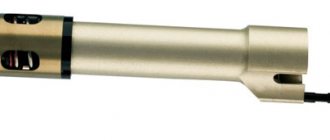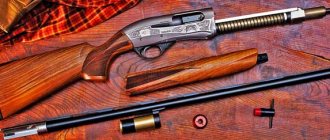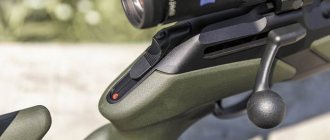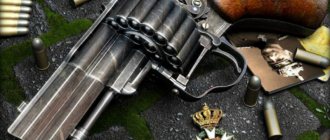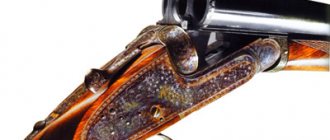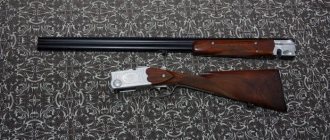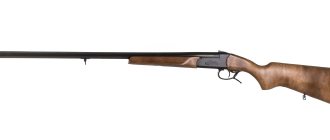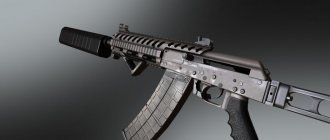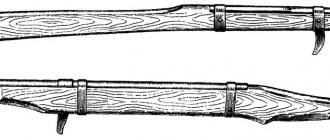The legendary gunsmith engineer John Browning began developing a self-loading gun for hunting back in 1898, and soon he assembled his first prototype and tested it in practice. At that time, hunters used classic single-barreled or double-barreled shotguns, and repeating shotguns with quick manual reloading were just appearing.
Developed by an engineer, the Browning Auto 5 self-loading rifle was the first self-loading shotgun in the world to be mass-produced.
Browning Auto 5 is an icon of many generations of hunters around the world, the world-famous first serial self-loading weapon for hunters. Browning Auto 5 was developed by Browning in 1898, patented in 1900, and was produced unchanged for a hundred years, and for this reason is listed in the Guinness Book of Records. The gun has gained popularity due to its large magazine capacity, automatic reloading, excellent workmanship and reliable automatic operation.
Browning Auto 5 was produced in a huge circulation of about 3 million copies over a hundred years. The gun, produced by arms factories in Belgium, the USA, Italy and even Japan, served as the basis for numerous imitations in various countries.
Development and creation
During development, several versions of a self-loading gun appeared, where the recoil energy of the barrel was used for reloading. The cartridges were used with smokeless powder. The most promising last option was chosen for further development. It differed from its predecessors in its high performance and more successful design. It was decided to bring it to mass production. After a short period of improvement, the self-loading rifle project was completed and offered to a potential manufacturer. In addition, the designer filed a number of applications for registration of inventions and received four patents.
A little later, after the start of mass production, the new gun received the symbol Browning Auto-5. This name reflected the possibility of automatic reloading, and the number indicated ready-to-use ammunition in the form of four rounds in the magazine and one in the chamber.
Initially, Browning Auto 5 was planned to be sold as a development to Winchester, which by that time had acquired 44 weapon systems created by Browning. But the plant management, represented by Bennett, refused, due to the weak prospects of these weapons. The second company, Remington Arms Co., also gave a negative answer. The famous designer turned to the Belgian company Fabrique National, where the production of his pistols had already been established. The new development was received positively, and Braunig placed an order for the first batch of ten thousand firearms for subsequent sale in America.
The very first copy of this weapon model, serial number 1, was sent to John Moses Browning on September 17, 1903.
All guns were sold out within one year. Soon the designer asked Fabrique National to partially transfer the right to produce and sell the new gun to Remington Arms, which immediately launched the production of Remington Model 11 guns, which were practically no different from the Belgian version.
The Browning gun turned out to be the most successful and widespread not only for its time, but also throughout the twentieth century. During the Second World War, the gun performed well in battle.
Application
The main users of the new guns were hunters and sports shooters. The ability to fire multiple shots without the need for constant manual reloading has become a noticeable advantage over other guns of the same class. Such advantages often became a decisive factor in the purchase, capable of leveling out a noticeable difference in price.
In addition, self-loading rifles have attracted the attention of several armies. For example, during the interwar period, a significant number of Belgian-made Auto-5 shotguns were purchased by the British Army. Having analyzed the experience of the First World War, in which some armies used trench brooms, such as the Winchester M1897 shotgun, the British military decided to strengthen infantry units with self-loading rifles.
In the British Army, Browning Auto-5 shotguns were designated L23A1. During the Second World War, this weapon was actively used in various operations, primarily in the fight against Japanese troops in Southeast Asia. The guns remained in service after World War II.
The method of using J.M.'s guns is interesting. Browning, used in US military aviation. The guns were mounted on special machines that imitated the machine gun mounts of bombers, which made it possible to carry out initial training of shooters.
This approach made it possible to practice weapon aiming with significant savings in ammunition. A number of Auto-5 rifles have also been used in infantry service for a long time.
General description of Browning Auto 5
Browning's use of a new principle of automatic operation - recoil of the barrel during a long stroke - determined the characteristic features of the new product:
- locking the barrel bore with a swinging cylinder (stop);
- combining the functions of feeder and shutter delay in one mechanism;
- control of the operation of stopping cartridges with a movable barrel;
- shock release of the bolt from the bolt stop using the rim of the next cartridge case;
- operation of the trigger without forced separation of the trigger and sear;
- regulation of the rollback speed of the moving parts by the friction brake of the recoil device, depending on the power of the cartridge used and the ambient temperature;
- extraction of the cartridge case when the barrel is returned to the forward position, when the pressure of the powder gases in the barrel drops to atmospheric;
- manual shutdown of the magazine.
The new Browning smoothbore self-loading shotguns were developed taking into account the experience of creating other systems that have a manual reloading option. For example, the general layout was taken from other samples. A magazine with a forend and a barrel located on it is attached to the front of the box. A butt of the desired shape is attached to its rear part. This rifle architecture subsequently created the opportunity to carry out certain upgrades regarding the ergonomics of the system, without introducing significant changes to the internal mechanics.
In the first project of a smoothbore weapon, designer John Moses Browning envisioned equipping the gun with wood fittings. An under-barrel forend and a butt with a protrusion in the shape of a pistol grip were used. In the applied neck, it was planned to install a small-diameter channel running deep inside the part. This is where the casing with the bolt spring located in it, responsible for the return, should have been located.
The basic version of the Browning Auto 5 was equipped with a 12-gauge barrel and could handle the appropriate shotgun loads. Subsequently, variants of guns began to be created that were suitable for other 16 and 20 caliber cartridges. The creation of such models was made possible thanks to successful automation, capable of adapting to firing ammunition with different characteristics.
A5 Hunter High Grade
Luxury version of the A5 Hunter. Features a high-gloss finish to the barrel and receiver with intricate scrollwork and pheasant and mallard engravings; The butt and fore-end are made of walnut with a glossy varnish coating of class 2.5, with a weapon checkering.
| Technical | characteristics |
| Caliber | 12/76 |
| Total length, mm | 1210,1260 |
| Barrel length, mm | 660, 710 |
| Magazine capacity | 4+1 rounds |
| Receiver material | Aluminium alloy |
| Choke constrictions | Full, Modified, Improved Cylinder |
| Weight, kg | 3,0-3,1 |
Operating principle and design features
The Browning Auto-5 smoothbore self-loading shotgun uses the recoil energy of the barrel during its long stroke for automatic operation. After the shot, the barrel, rigidly coupled to the bolt, rolls back to the full length of the stroke, then the bolt stops in the rear position, the locking cylinder located in it releases the barrel, and it is under the influence of its return spring located under the barrel. around the magazine tube, begins to move forward.
The spent cartridge remains on the bolt mirror and after the barrel moves forward a sufficient distance, it is thrown out through the window in the receiver.
After the barrel reaches the forward position, it releases the bolt using a special lever. Under the action of the return spring located in the neck of the stock, the bolt begins to move forward, picking up the next cartridge from the feeder and sending it into the barrel. At the end of the bolt roll, the locking cylinder located in it swings upward, rigidly locking the cartridge in the barrel.
The design of the Browning Auto-5 shotgun includes a barrel braking system that provides a more or less stable recoil speed of the moving system for a fairly wide range of cartridge charges and projectiles. This system consists of several friction rings located between the barrel guide ring covering the tube of the under-barrel magazine and the barrel return spring.
The higher the recoil energy of the cartridge, the more strongly the friction ring is compressed by the adjusting ring located on its conical part from the outside, thereby increasing the friction between the ring and the magazine, and therefore introducing additional force that inhibits the recoil.
The Browning shotgun, chambered for Magnum cartridges, has two friction rings. If shooting is carried out with conventional charges, it is recommended to remove one of them. This system is critical to lubrication of the outer surface of the magazine tube, but with proper care and adjustments, the gun will operate reliably.
The Browning trigger trigger, the safety button is located at the base of the trigger. The cartridges are fed from a tubular magazine, the capacity of which is 4 charges, and the fifth is fed directly into the barrel.
Browning shotguns, made in Belgium, have a special lever on the left side of the receiver that cuts off the magazine to stop the flow of ammunition into the feed tray. This feature makes it possible to quickly replace the cartridge with another, more necessary charge. Remington guns did not have this feature.
As is known from the history of the concerns, when creating the Browning Auto 5, barrels with or without sighting strips could be used as additional equipment, and fixed or replaceable muzzle chokes of different lengths could be installed. A stock made of wood could also have differences in the quality of workmanship and finishing, and in the shaped features of the neck.
A5 Hunter
The buttstock is made of high-gloss Turkish walnut with a pistol grip, adjustable in length and angle with washers. Gloss black anodized receiver finish. Red fiber optic front sight and white bead in the middle of the barrel.
| Technical | characteristics | |
| Caliber | 12/76 | 12/89 |
| Total length, mm | 1210, 1260 | 1210, 1260 |
| Barrel length, mm | 660, 710 | 660, 710 |
| Magazine capacity | 4+1 rounds | 4+1 rounds |
| Receiver material | Aluminium alloy | Aluminium alloy |
| Choke constrictions | Full, Modified, Improved Cylinder | Full, Modified, Improved Cylinder |
| Weight, kg | 3,0-3,1 | 3,1-3,2 |
Technologies
According to experts, the Browning gun is so reliable that it can be safely given a guarantee for one hundred thousand shots or five years of operation. The gun works flawlessly; the mechanism remains practically clean after firing, because the bulk of the gases exit through the barrel, bypassing the mechanics.
For self-loading shotguns, Speed Loading technology has been popular for decades. The loading mechanism sends the first cartridge directly into the chamber. Browning is unloaded thanks to Speed Unload technology, which allows you to quickly remove all cartridges from the magazine without using the bolt handle.
The Total Barrel Dynamics system is represented by a set of special characteristics that allow the Browning shotgun to surpass other analogues in terms of service life and combat accuracy. The first of these components is a high-quality steel barrel, absolutely impervious to shot. Next up is a combination of Back-bored technology and Vector Pro extended chamber taper. This combination minimizes friction and pressure on the shot charge, reduces deformation, and increases speed. The Invector-DS muzzle attachment is responsible for high-precision shooting. In general, with a system like Total Barrel Dynamics, you completely eliminate any accidents.
Invector-DS attachments bring the concept of thin-walled muzzle-mounted attachments to a new level of performance independent of open field, swamp, woodland or shooting conditions.
The Turn Key magazine plug is easy to remove and install. To do this, remove the cover, insert a car key or screwdriver into the plug, press and turn. The installed plug allows you to load the magazine with only three cartridges, which fully complies with the rules of hunting migratory birds. In addition, the plugs were used for initial training in shooting from Browning.
The shock absorber, designed using Inflex II technology, belongs to the next generation of devices with a higher degree of absorption. The material perfectly cushions and glides, preventing the fabric from creasing when firing from the shoulder. The special design of the butt goes down and away from the shooter’s cheek, which improves shooting comfort and increases the speed of the next shot.
Advantages and disadvantages of Browning Auto-5
Needless to say, the legendary self-charging device has plenty of advantages. Let's list them:
- Automatic reloading of the gun.
- Reliability of mechanisms.
- High rate of fire.
- High accuracy.
- Slight barrel recoil during shooting.
- The elements of the gun are easily replaceable; they are made of high-quality steel.
Let's note a couple of disadvantages:
- For normal shooting, you should use high-quality cartridges with folder sleeves.
- The mechanisms of the gun are quite complex and require regular maintenance.
Where can I buy
Now on the Russian market you can find a decent Browning Auto 5, but these guns are very expensive, especially in large cities. Having caught on to the situation, Auto 5s produced in the 70s and 80s began to be imported to Russia from the USA, so that, if desired, you can purchase the legendary gun in perfect condition. Although, of course, it is the old guns that are most attractive.
For the most part, Browning Auto-5, which are in the hands of our hunters, are guns of old releases, including pre-revolutionary ones, worn white and not always in good technical condition. As practice shows, with timely and competent care, when using properly assembled cartridges, the gun is practically indestructible.
But in Russia, a gun was almost always a tool, so they didn’t stand on ceremony with the Brownings, especially in the conditions of the post-war shortage of hunting consumables.
Let us note that the confiscation of guns, with the beginning of the Great Patriotic War, severely reduced the number of hunting weapons among the population.
Thanks to the long projectile port, Brownings with 65 mm chambers (there are also 70 mm chambers and magnum cartridges) normally fire cartridges with a 70 mm sleeve, although this sometimes requires a little boring of the window for ejecting the cartridges. 65 mm chambers were also bored to 70 mm in length, which, of course, did not have the best effect on the condition of the guns.
But there are few functional shotguns with a 65 mm chamber left, and a 70 mm chamber solves all the problems associated with non-standard cartridge case length. The Auto-5's fore-end sometimes breaks, which, for all its elegance, has very thin walls. There are problems with recharging if there is too much grease on the friction rings or if they are installed incorrectly.
Any self-loading weapon is not absolutely reliable, and the Browning Auto-5 is no exception. But, subject to basic operating conditions, the gun is quite reliable and can serve a careful hunter for the rest of his life, bringing sincere joy from owning a rare and rewarding weapon.
A5 Stalker
Black composite version A5
| Technical | characteristics |
| Caliber | 12/76, 12/89 |
| Total length, mm | 1210, 1260 |
| Barrel length, mm | 660, 710 |
| Magazine capacity | 4+1 rounds |
| Receiver material | Aluminium alloy |
| Choke constrictions | Full, Modified, Improved Cylinder |
| Weight, kg | 3,25-3,4 |
Often referred to as the “gentleman's gauge,” the intermediate 16 is for many hunters the ideal ammunition for the ideal gun. A well-designed 16 gauge is closer in weight to a 20 gauge, with a shot payload closer to a 12 gauge and an accuracy that beats them both. Like its predecessor, the 16-gauge Browning A5 is built on a smaller, lighter receiver to reduce weight.
| Technical | characteristics |
| Caliber | 16/70 |
| Total length, mm | 1200, 1250 |
| Barrel length, mm | 660, 710 |
| Magazine capacity | 4+1 rounds |
| Receiver material | Aluminium alloy |
| Choke constrictions | Full, Modified, Improved Cylinder |
| Weight, kg | 2,6 |
As a conclusion
Already at the very beginning of the last century, soon after the start of production, self-loading shotguns by J.M. Browning attracted the attention of potential buyers. In addition, over time, this development became of interest to other gunsmiths. As a result, several new guns entered the market, based on the Auto-5 mechanics, but produced by other companies. These or other copies or converted versions of J.M.'s gun. Brownings are still produced and have a certain distribution.
Back at the end of the 19th century, J.M. Browning managed to develop the world's first smoothbore shotgun with the ability to reload itself. This sample soon became the first representative of its class to be produced in series and put on the market. Finally, the Browning Auto-5 shotgun holds another record. This weapon was produced for almost 100 years without significant design changes: all changes concerned only individual parts and did not affect the automation. Thus, designer J.M. Browning managed to create a unique and outstanding weapon in every sense.
Will nature have a rest on the A5?
For a number of reasons, not everything that was created by one of the greatest weapons designers of the late 19th and early 20th centuries, John Browning, was embodied in metal and put into mass production. And not everything that was put into mass production bore the name of its creator. Most of the time, John Browning worked for the Winchester company, whose management made the decision on the advisability of launching a particular model into series. In 1879, John and his brother Matthew sold a patent to Winchester for a single-shot rifle called the Mod. 1885. By the way, many models and samples of weapons designed by Browning were produced by companies such as Colt, Remington, Stevens and Winchester, but the name of the designer was modestly kept silent by the manufacturers.
The models of weapons created by John Browning, launched into series, also testify to the genius of the designer. So, the Winchester Mod pump-action shotgun. The 1987 was produced for 60 years, the world's first mass-produced over/under model, the Superposed B-25, was produced for 70 years, and the Auto-5 semi-automatic was produced for 95 years! From a design point of view, the Auto-5 semi-automatic was perhaps technically the most advanced.
Browning managed to solve the problem of using the energy of powder gases to reload military weapons. Therefore, it was absolutely logical to apply existing developments to create a model of a semi-automatic hunting rifle with a gas exhaust mechanism, i.e. using part of the powder gases for reloading.
The semi-automatic device was received with a bang in various countries around the world. The Russian hunting magazine of that time, Okhotnichiy Vestnik, which was extremely popular, wrote that “the magazine will revolutionize the hunting world: you can fire 5 shots in 15 seconds at a rising flock of geese, without taking the gun off your shoulder... This gun can be called a miracle of weapons technology.”
The Auto-5 semi-automatic machine was extremely reliable. Guns produced at the beginning of the last century continue to delight their owners with faithful combat. The catalog of that time about the Auto-5 said: “This gun is distinguished by its reliable design. Regular maintenance, care and careful handling will ensure many years of trouble-free operation. The cost of operating the gun will be equal to the amount you paid upon purchase; your gun will not require any other expenses.”
There is, however, not entirely confirmed information that over the years since the start of production of the Auto-5, more than ten million copies of this gun have been sold worldwide.
In 1976, production of the Auto-5 was moved from Belgium to Japan to the Miroku plant, and mass production of this gun model ended in 1998. However, highly qualified Belgian gunsmiths in Gerstal continued to produce guns of this model in single copies.
At the beginning of 2003, hunters, collectors and gun lovers had the chance to compete at auction for the opportunity to purchase a unique copy of the Browning Auto 5, specially assembled by Belgian gunsmiths in honor of the centenary of the release of the first copy of this popular model of hunting weapon. donated this memorial copy to the SHOT Show organizing committee as one of the auction lots. All proceeds from the sale of the gun at the auction went to the fund for the development of hunting and shooting sports.
Throughout most of the last century, Auto-5 enjoyed continued popularity. This 20-gauge and 16-gauge semi-automatic was a favorite weapon for hunting swamp and meadow game, and with a 12-gauge magnum chamber it was exceptionally suitable for hunting waterfowl.
This gun was also appreciated by athletes, for whom it was produced in the “ladder” and “skeet” versions. At the 1924 Paris Olympics, the Auto-5 won a gold medal and set a world and Olympic record. The semi-automatic Mod. released by Remington. 11-48, which was essentially a restyled model of its famous ancestor, was extremely popular among athletes who shot skeet. It is thanks to Auto-5 (in the Remington Mod. 11 version) and Mod. 11-48 changed the attitude of shooters towards semi-automatics in general; it was these semi-automatic models that in the 1960s prepared and predetermined the success of another semi-automatic model from the Remington 1100.
Of course, these days it is almost impossible to see an Auto-5 in the hands of a shooter on a license plate at high-level sporting events. New times need not only new songs, but also new weapons. But Auto-5 continues to serve hunters, including Russian ones, as reliably as it did 20, 50, and 100 years ago. It’s a little sad - the great gun of the great designer, which reigned unchallenged and rightfully in the arsenal of hunters all over the world, has given up its throne to other guns.
It seems that only recently the Browning company presented a new model of the Maxus gas-operated self-loading shotgun, which literally immediately won the sympathy of hunters in various countries around the world, when suddenly a new sensation - the company is entering the market of self-loading weapons with another new product! But were Browning's marketers mistaken when they decided to take an extremely bold step? Firstly, the coming year, when the official presentation of the new product will take place, according to economists, is expected to be unfavorable, and secondly, the company will have to compete for the contents of the wallets of potential buyers on a foreign field. The fact is that the self-loading gun, named A5 in honor of its great predecessor, has nothing in common with it, except, perhaps, a similar name and the nostalgic shape of the receiver. The fact is that the A5 is the first model in the history of the company’s production of self-loading hunting weapons with an inertial reloading mechanism that uses the recoil energy of the entire gun. The automatic operation of such a gun is based on the recoil of a compound bolt with a so-called inertial body. The heart of the mechanism is a powerful spring located in the frame of the bolt, which, accumulating energy during the recoil of the weapon, then provides a full cycle of operation of the gun’s automation. Thus, the weapon does not contain gas engine parts, its mechanisms become less dirty, the weapon does not require particularly careful maintenance, and the simplicity of the design is the key to its reliability.
That's what the theory sounds like. The theory, despite its apparent simplicity, was implemented in practice by only an extremely limited number of weapons manufacturers. This, of course, is primarily Benelli and Breda (the design and launch of a number of models of self-loading weapons with an inertial reloading system were carried out with the direct participation of Bruno Civolani), as well as Marocchi and Fausti Stefano. Turkish companies, for example ATA Arms, also produce semi-automatic devices with an inertial reloading system, but no other company has such a variety of models as Benelli.
What advantages do guns with an inertial reloading mechanism have? Firstly, these guns are not critical to frequent cleaning and maintenance, and in this regard, they are of particular interest to that part of the hunters who sometimes forget to clean the weapon before putting it in the safe. In this regard, such guns are in no way inferior to weapon systems that operate on the principle of barrel recoil with its long stroke, and in some ways even surpass them. Another undeniable advantage of shotguns with an inertial reloading mechanism is that it does not require a pressure regulator when using cartridges of different power. It is also characterized by very low vibration levels and a high rate of fire. Very important advantages of shotguns with an inertial reloading system are the simplicity of the design, as well as the ease with which they can be disassembled without the use of special tools, and the small number of parts.
| Browning A5 |
So, what did Browning do? Externally, the semi-automatic has retained the traditional features inherent in Brownings, but the “filling” is more like a Benelli (some weapons experts even specify the model as Montefeltro). A 12-gauge shotgun with a barrel length of 71 cm (also available with 66 and 76 cm barrels) weighs just over 3.15 kg. The impressions from the gun are the most favorable: the correct distribution of weight among the units ensures exceptional handling. In principle, the gun is distinguished by its readiness to “digest” almost any cartridges. Tests carried out with lightweight hunting cartridges with a 28 g load showed that the automation works. Moreover, manufacturers claim that reliable operation of the automation is possible even with a 24 g load! (A couple of years ago, during a visit to the Benelli plant in Urbino, I asked a question about the minimum load of shot that can ensure the automatic operation. Representatives of the plant said that tests had shown that firing cartridges with 28 g of shot - the standard shot load for sporting - was possible, but cartridges with a 24 g load can only be used in the Supersport model.) The kinetic energy of a gun’s recoil depends on three quantities: the mass of the projectile, its initial speed and the burning speed of the powder charge.
Representatives of the Browning company stated that the A5 is, in their opinion, the most reliable, with the highest rate of fire and the weakest recoil of the inertial semi-automatic machines. In support of the thesis about reliability, company representatives stated that they provide a five-year guarantee for the new model, noting that they estimate the survivability of the semi-automatic at 100 thousand shots. I wonder if the 5 year warranty will apply to A5 shotguns sold outside the US?
Modern weapons, unlike their predecessors, are not just barrels, a block with a trigger installed in it, a fore-end and a butt. Modern weapons are, first of all, a symbiosis of advanced technologies that provide high consumer qualities, reliability and durability. The new model of Browning self-loading shotgun was no exception.
Firstly, there is the compound shutter itself. Currently, the inertial reloading system is not protected by a patent. In principle, any manufacturer can buy a Benelli gun, disassemble it, copy it and put it into production. But this doesn't happen! Naturally, the question arises, why don’t the world’s leading arms companies produce hunting weapons with an inertial reloading system? Yes, because to ensure uninterrupted operation of the reloading mechanism, the highest precision in the manufacture of all parts is necessary. Such precision can only be achieved on automated or robotic lines and machines. But that's not all. You can copy parts and the finished product assembly, but the most important thing is the production technology. Trying to reproduce it is an impossible task.
The designers of the Browning company did not go by copying, but modernized the shutter, managing to bring it to a state close to absolute perfection. (A small lyrical digression. One of the Benelli brothers, Giovanni, was fond of hunting and in 1940 he designed a 12-gauge self-loading shotgun. The design was based on John Browning’s concept, which he implemented in the Auto-5, but compared to the Auto-5, the gun Giovanni Benelli had a more advanced trigger mechanism. The innovations made by Giovanni Benelli in the design of the trigger were even protected by four patents. And although Browning engineers did not make innovative changes to the design of the reloading mechanism, we will assume that the score in the Benelli-Browning batch is still 1 :1.)
The barrel shoots, the stock hits, Ludwig Krieghoff said in 1900. Since then, this statement has become an axiom, but let me note that it is the barrel that shoots. Browning designers worked hard to improve the barrel profile. Thus, the extended Vector Pro projectile entry and Back-Bore drilling help reduce the deformation of pellets when changing lanes and passing through the bore. Thanks to this, combat characteristics are improved and shooting comfort is increased due to the reduction in the impact of recoil force on the shooter.
Replaceable double seal Invector-DS chokes contribute to high performance. The chokes are equipped with a copper gasket that prevents the breakthrough of powder gases into the space between the inner surface of the barrel and the outer surface of the choke.
| Browning A5 |
Improving shooting comfort is an extremely important task. The new Inflex II recoil pad is a new generation of shock absorbers, and in addition to reducing the force of recoil on the shooter's shoulder, it also directs the vector of force downwards, thus protecting the shooter's face from shock and vibration at the moment of firing. Thanks to the use of a new generation buttplate-shock absorber, barrel toss is reduced, which reduces the time it takes for the gun to return to the aiming line, and the stability of the gun is maintained during a quick raise and during a shot. Let me remind you that the practical rate of fire of a hunting rifle consists of the following components: raising, aiming at the target, firing and returning the rifle to the aiming line for the next shot.
The shape of the receiver was chosen not only for marketing reasons involving nostalgia. The main factor that determined the choice in favor of this particular form was the lengthening of the aiming line, which makes aiming at the target more comfortable.
It has already been announced that the new model of a self-loading shotgun will be produced in four versions - Hunter (with a walnut stock), Stalker (black plastic stock) and two versions in Mossy Oak and Mossy Oak Duck Blind camouflage.
The last two questions remain - when and how much. The official presentation of the new model in the United States will take place at the SHOT Show in Las Vegas in January 2012, sales in the United States (tentatively) will begin in the spring of 2012. As for the price of the gun, the manufacturer's suggested retail price for the cheapest version is $1,399.
It is expected that in March 2012 the gun will be presented at the IWA exhibition in Nuremberg. It is possible that in October Browning will bring this model to the “Weapons and Hunting” exhibition in Moscow.
Time will tell how strategically correct the Browning company's decision to begin production of a self-loading shotgun with an inertia reloading mechanism was and how accurately they chose the timing. Time will tell whether the new Browning will prove to be a worthy rival to the Benelli. Time will tell whether the A5 will enjoy the same love among hunters as its predecessor, the great (without exaggeration) and reliable Auto-5. In the meantime, Benelli representatives, to whom I contacted for comment, said that “they are closely monitoring developments.” By the way, to be completely frank, the Benelli company did not strictly maintain technological virginity and loyalty to the strategic course it had once taken. Thus, after a competition was announced in 1998 to develop a new self-loading smoothbore shotgun with a GAS vent reloading system for the needs of the US Army, Benelli took part in it and won a brilliant victory. In 1999, the first batch of M1014 rifles, better known in our country as Benelli M4 Super 90, in the amount of 20 thousand, was delivered to the US Marine Corps through Heckler & Koch.
Mikhail Gobozov
